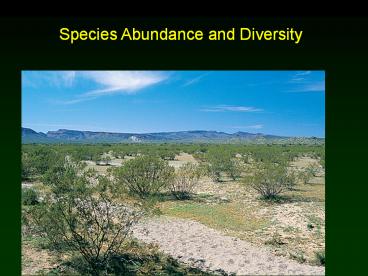Species Abundance and Diversity - PowerPoint PPT Presentation
Title:
Species Abundance and Diversity
Description:
Species Abundance and Diversity Introduction Community: Association of interacting species inhabiting some defined area. Community Structure includes attributes such ... – PowerPoint PPT presentation
Number of Views:244
Avg rating:3.0/5.0
Title: Species Abundance and Diversity
1
Species Abundance and Diversity
2
Introduction
- Community Association of interacting species
inhabiting some defined area. - Community Structure includes attributes such as
number of species, relative species abundance,
and species diversity. - Guild Group of organisms that all make their
living in the same fashion. - Seed eating animals in the desert.
- Life Form Combination of structure and growth
dynamics.
3
Species Abundance
- There are regularities in the relative abundance
of species in communities that hold irregardless
of the ecosystem. - Preston developed concept of distribution of
commonness and rarity.
4
Lognormal Distribution
- Preston graphed abundance of species in
collections as frequency distributions. - Lognormal Distributions
- Bell-shaped curves.
- In most lognormal distributions, only portion of
bell-shaped curve is apparent. - Sample size has large effect.
- Significant effort to capture rare species.
5
Lognormal Distribution
6
Lognormal Distribution
- May proposed lognormal distribution is a
statistical expectation. - Sugihara suggested lognormal distribution is a
consequence of the species within a community
subdividing niche space.
7
Species Diversity
- Two factors define species diversity
- Species Richness
- Number of species in the community.
- Species Evenness
- Relative abundance of species.
8
Species Diversity
9
Quantitative Index of Species Diversity
- Shannon Wiener Index
- s
- H -Spi logepi
- il
- H Value of SW diversity index.
- Pi proportion of the ith species.
- Loge natural logarithm of pi.
- S Number of species in community.
10
(No Transcript)
11
Rank Abundance Curves
- Can also portray relative abundance and species
diversity within a community by plotting relative
abundance of species against their rank in
abundance. - Greater evenness indicated by lower slope.
12
Rank Abundance Curves
13
(No Transcript)
14
Environmental Complexity
- In general, species diversity increases with
environmental complexity or heterogeneity. - MacArthur found warbler diversity increased as
vegetation stature increased. - Measured environmental complexity as foliage
height. - Many studies have shown positive relationship
between environmental complexity and species
diversity.
15
Environmental Complexity
16
(No Transcript)
17
Niches and Diversity of Algae and Plants
- Hutchinson
- Phytoplankton communities present a paradox
because they live in relatively simple
environments and compete for the same nutrients,
yet many species coexist without competitive
exclusion. - Environmental complexity may account for
significant portion of the diversity.
18
Niches and Diversity of Algae and Plants
- Algal niches appear to be defined by their
nutrient requirements. - Tilman found coexistence of freshwater diatoms
depended upon ratio of silicate and phosphate. - Found conditions allowing coexistence.
- Diatoms held different trophic niches.
- Thus different diatoms would dominate different
areas.
19
(No Transcript)
20
(No Transcript)
21
Heterogeneity and Diversity of Tropical Forests
- Jordan concluded tropical forest diversity
organized in two ways - Large number of species live within most tropical
forest communities. - Large number of plant communities in a given
area, each with a distinctive species
composition.
22
Heterogeneity and Diversity of Tropical Forests
23
Algal and Plant Species Diversity and Increased
Nutrient Availability
- Repeatedly observed negative relationship between
nutrient availability and algal and plant species
diversity. - Adding nutrients to water or soils generally
reduces diversity of plants and algae. - Reduces number of limiting nutrients.
24
(No Transcript)
25
(No Transcript)
26
Disturbance and Diversity
- Disturbance difficult to define as it involves
departure from average conditions. - Average conditions may involve substantial
variation. - Sousa defined disturbance
- Discrete, punctuated, killing, displacement, or
damaging of one or more individuals that directly
or indirectly creates an opportunity for new
individuals to be established.
27
(No Transcript)
28
Disturbance and Diversity
- White and Pickett defined disturbance
- Any relatively discrete event in time that
disrupts ecosystem, community, or population
structure and changes resources, substrate
availability, or the physical environment. - Two major characteristics
- Frequency
- Intensity
29
Intermediate Disturbance Hypothesis
- Connell proposed disturbance is a prevalent
feature that significantly influences community
diversity. - Proposed both high and low levels of disturbance
would reduce diversity. - Intermediate levels promote higher diversity.
- Sufficient time between disturbances allows wide
variety of species to colonize, but not long
enough to allow competitive exclusion.
30
Disturbance and Diversity in the Intertidal Zone
- Sousa studied effects of disturbance on diversity
of algae and invertebrates growing on boulders in
the intertidal zone. - Predicted level of disturbance depends on boulder
size. - Large boulders require more force to move.
- Boulders supporting greatest diversity of species
were those subject to intermediate levels of
disturbance.
31
Disturbance and Diversity in the Intertidal Zone
32
Disturbance and Diversity inTemperate Grasslands
- Whicker and Detling Prairie dogs (Cynomys spp.)
source of disturbance on N. A. prairies. - Build extensive burrow systems.
- Remove vegetation around burrows.
- Area opens to colonization.
- Pest control programs reduced prairie dog
populations 98. - Eliminated dynamic influences on plant
communities.
33
(No Transcript)
34
(No Transcript)
35
(No Transcript)

